Introduction
Autism spectrum disorder (ASD) is diagnosed at a significantly higher rate in males compared to females, with current research indicating a ratio of approximately 4:1. This notable disparity raises critical questions about the underlying causes. Biological, genetic, and environmental factors all contribute to this uneven distribution, but societal expectations and diagnostic criteria, often based on male presentations of autism, may also play a significant role.
Females with autism frequently display different behavioral profiles and may engage in camouflaging or masking their autistic traits, complicating the diagnostic process. Often diagnosed later than their male counterparts, females face unique challenges that highlight the need for tailored diagnostic approaches. Understanding these factors is essential for improving diagnostic accuracy and providing better support for all individuals on the autism spectrum.
The Current Sex Ratio in Autism Diagnoses
Studies consistently indicate that spectrum disorder (ASD) is identified more often in males than in females, with a ratio of about 4:1. This significant disparity prompts an exploration into the underlying reasons. Various factors contribute to this uneven distribution, including biological, genetic, and environmental influences. 'Moreover, societal norms and diagnostic standards, which are frequently grounded in male manifestations of the condition, may result in underdiagnosis or misdiagnosis in women. Females with autism often exhibit different behavioral profiles and may engage in camouflaging, masking their traits to align with social norms, which complicates the diagnosis process. Research has shown that women are frequently identified later than men, underscoring the necessity for customized diagnostic methods. Intersectionality, a framework recognizing the interconnectedness of social categories such as gender and disability, can offer deeper insights into the unique challenges faced by autistic women. Comprehending these elements is essential for enhancing diagnostic precision and assistance for all individuals on the spectrum.
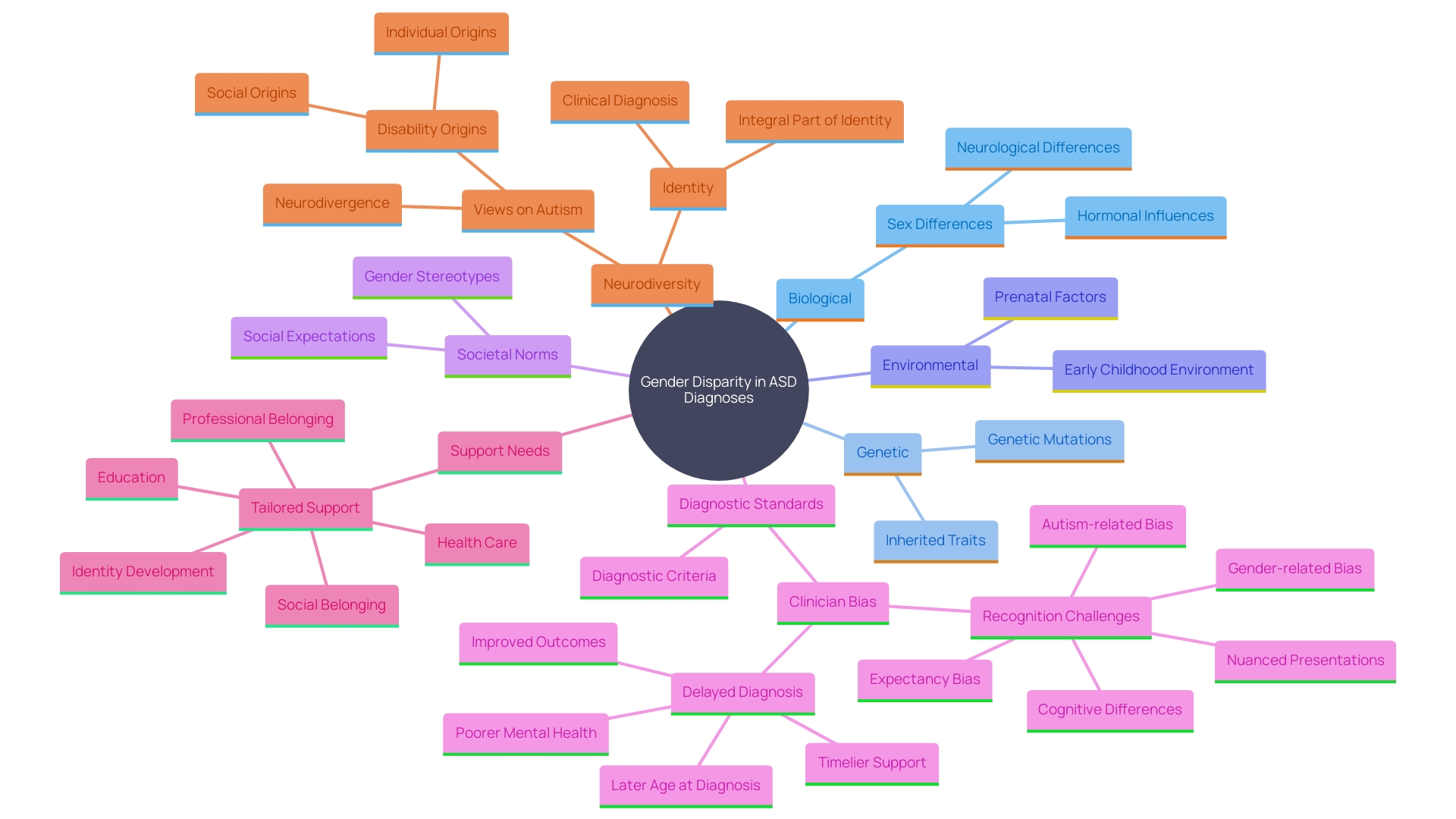
Biological Factors Contributing to Sex Differences
Studies have indicated that different biological elements play a role in the variations in prevalence of this condition between males and females. Genetic variations play a significant role, as evidenced by the complexity of heritability in spectrum disorders (ASD). Studies indicate that the intricate mechanisms of genetic influence are not solely tied to protein-coding regions of the genome but also involve non-coding regions, such as promoters, which control protein production. Moreover, hormonal influences, particularly the impact of sex hormones during critical periods of brain development, are believed to affect the likelihood of developing autistic traits differently in males and females. These hormonal differences can lead to variations in brain structure, further influencing how this condition manifests in each gender.
For instance, hormonal exposure in utero could impact the neural pathways associated with social behavior and communication, which are often areas of challenge for individuals with autism. This understanding is crucial, as it underscores the need for tailored diagnostic criteria and support systems that consider these gender-specific differences. Notably, research by clinical psychologists like Celia Romero and Jennifer Durocher emphasizes the importance of early identification and support for autistic girls. Prompt identification can lead to timely interventions, helping families access the resources they need for their children's success.
It's also essential to acknowledge that societal expectations and diagnostic biases have historically led to the underdiagnosis of the condition in females. Females may present with subtler symptoms or develop coping mechanisms that mask their autistic traits, making it harder for them to receive an accurate diagnosis. By continuing to explore these gender differences, scientists can develop more effective diagnostic tools and support strategies, ultimately benefiting all individuals on the spectrum of autism-related conditions.
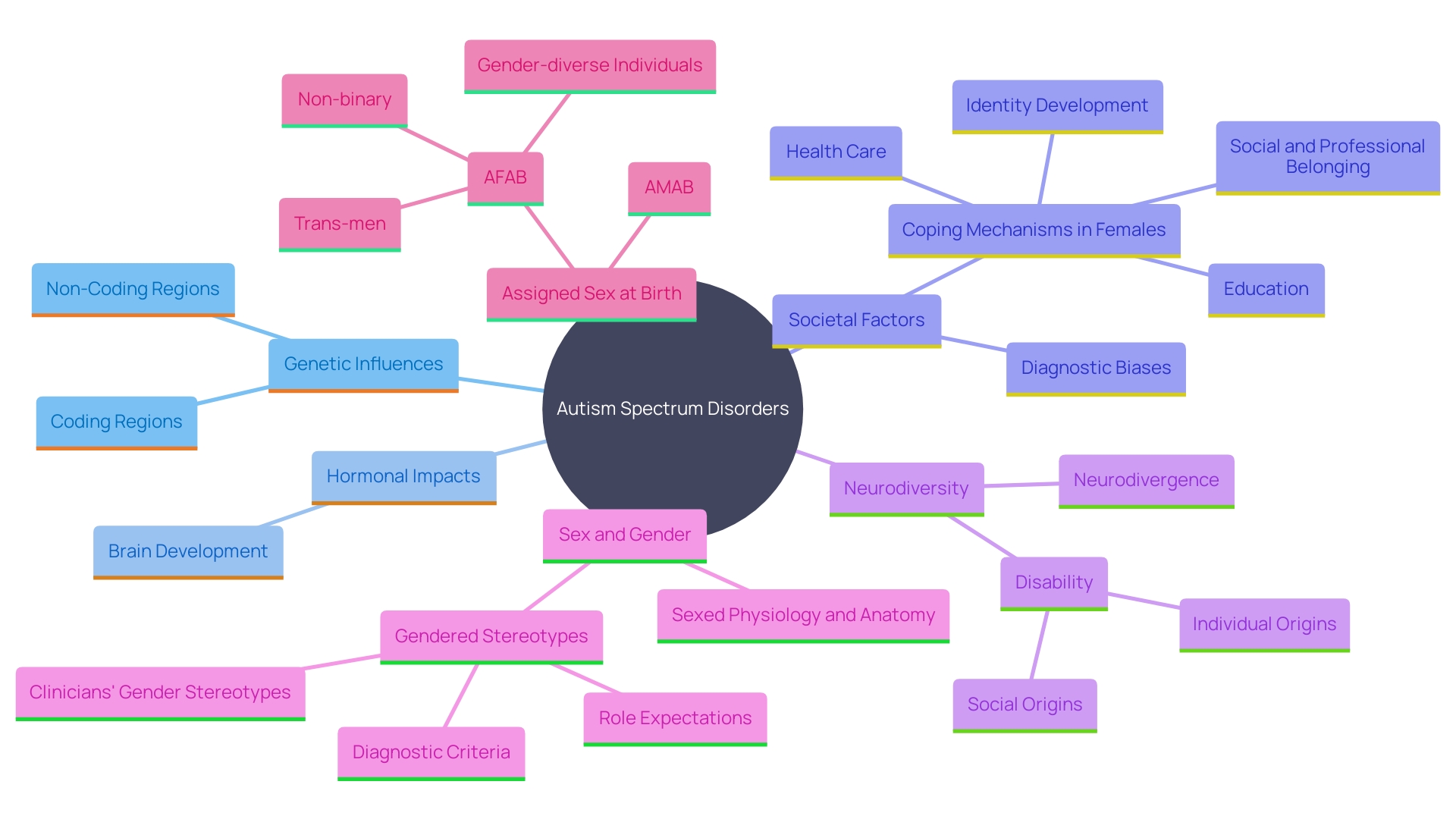
The Female Protective Effect Hypothesis
The protective effect hypothesis suggests that women may possess inherent biological or genetic defenses that lower their chances of developing autism. This theory proposes that women need a greater genetic load or more substantial environmental stimuli to exhibit traits associated with autism, which might clarify the diminished diagnosis rate in women relative to men. Recent research highlights that females on the spectrum are often underdiagnosed, misdiagnosed, or diagnosed later in life, partly due to the differences in how symptoms manifest between genders. For instance, studies have shown that girls with this condition may have less severe symptoms and more nuanced behavioral profiles than boys, which can lead to their symptoms being overlooked. This underdiagnosis can lead to a lack of appropriate support and intervention for girls on the spectrum, affecting their development and quality of life. Comprehending and tackling these gender distinctions is crucial for enhancing assessment and assistance for all individuals on the spectrum. As Jennifer Durocher, a clinical psychology professor, emphasizes, tailored support and early identification are crucial for the well-being of autistic individuals and their families. With these insights, we can work towards a more inclusive approach to diagnosis and support related to this condition, ensuring that no one is left behind.
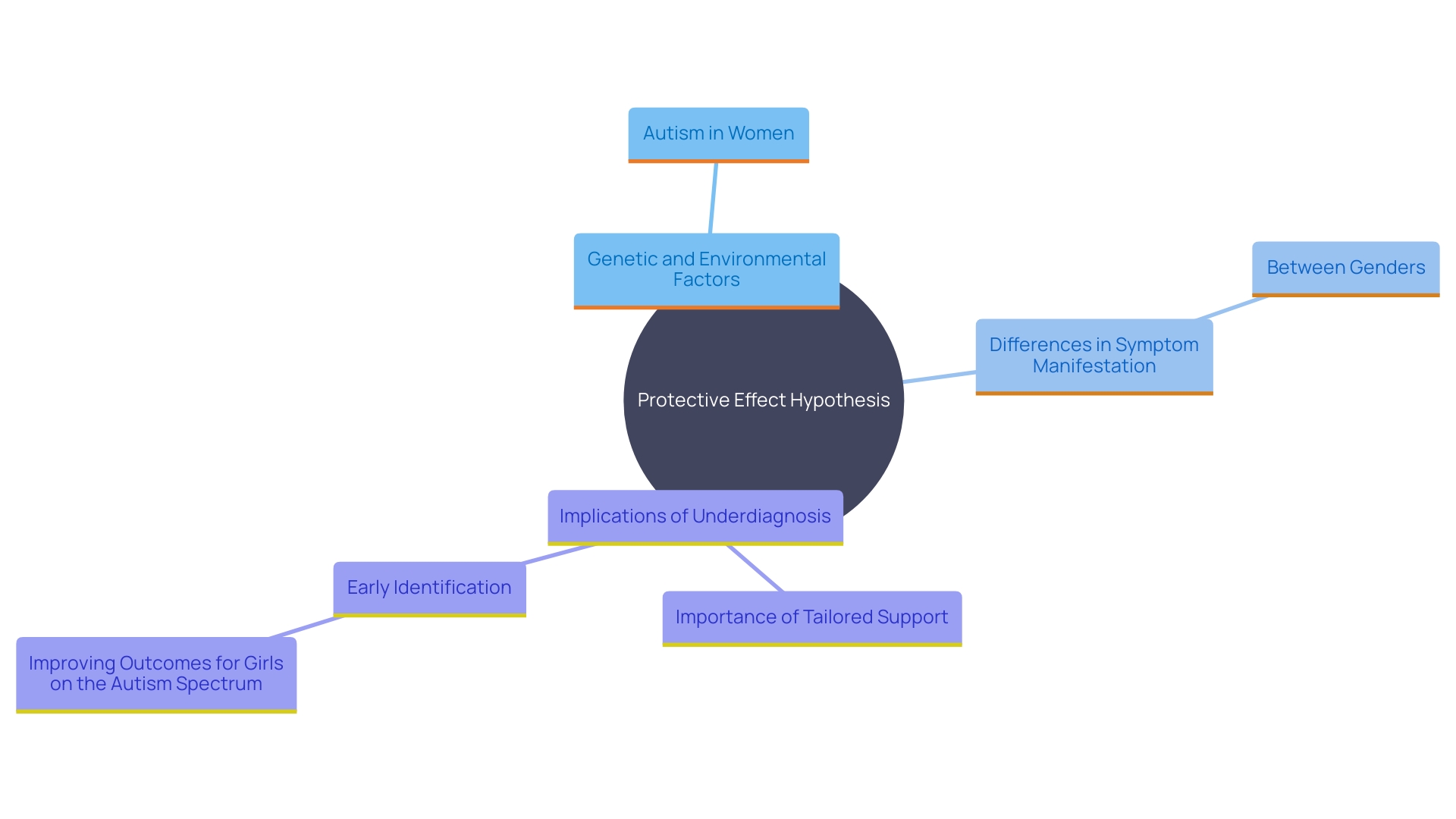
Diagnostic Biases and Underdiagnosis in Females
Diagnostic biases can significantly influence the recognition of the condition in women. Healthcare professionals frequently identify the typical signs of the condition in males, possibly missing the more nuanced expressions observed in women. As a result, many girls with autism may remain undiagnosed or misdiagnosed, leading to a lack of appropriate support and interventions. Studies indicate that 80% of women on the spectrum remain undiagnosed or misdiagnosed by age 18, often leading to significant mental health issues. Women on the spectrum and non-binary individuals face mental health challenges more frequently than men on the spectrum, with 77% of women on the spectrum and 62% of men on the spectrum diagnosed with a psychiatric condition by age 25. This underdiagnosis can lead to significant challenges, including the need for these individuals to mask their symptoms to appear neurotypical, which can result in exhaustion and meltdowns at home. Tackling these diagnostic biases is essential for offering the required assistance and ensuring improved mental health results for females on the spectrum.
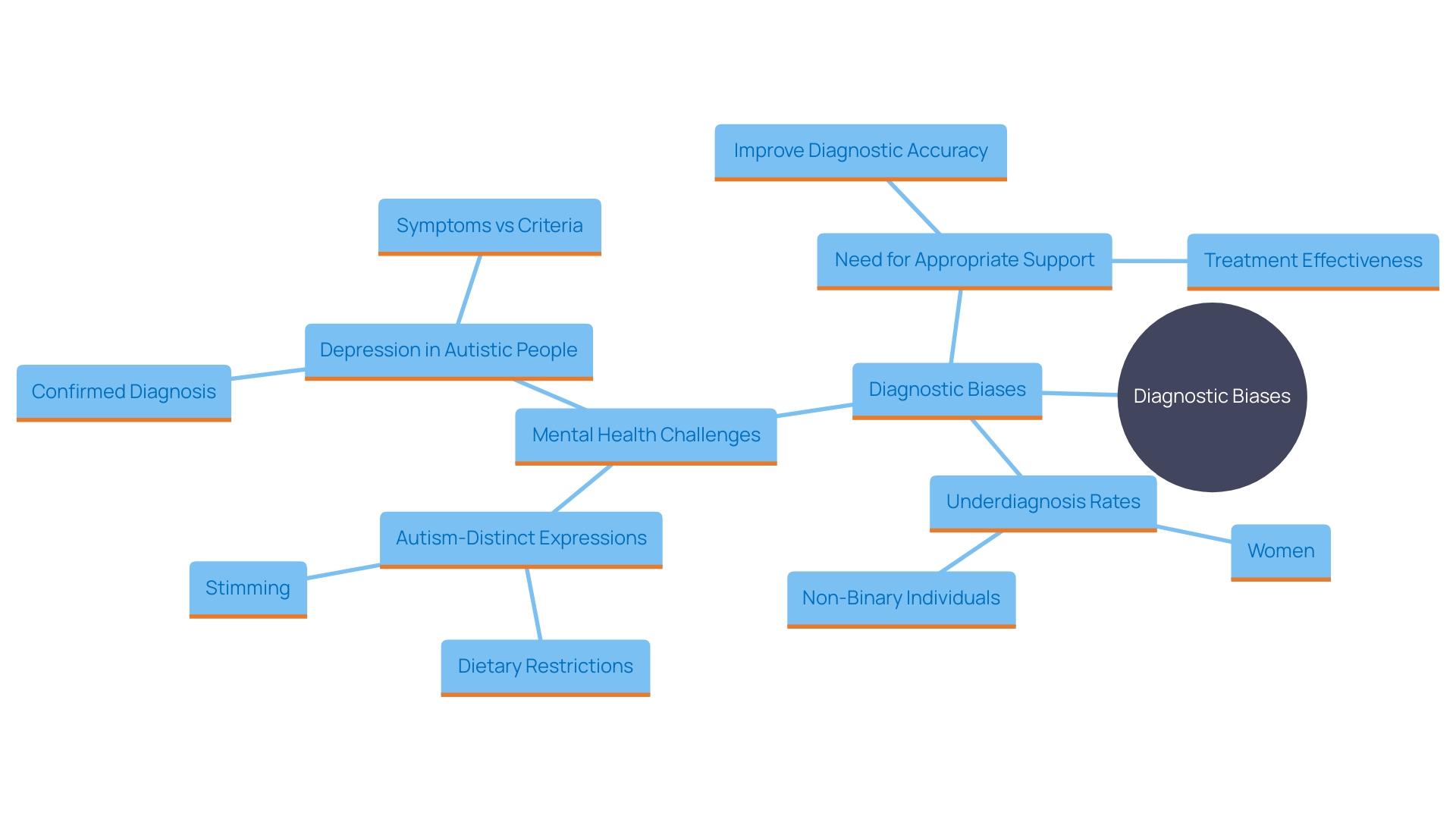
Behavioral Differences and Masking in Females
Females with developmental conditions often exhibit different behavioral patterns compared to males. Many girls may engage in masking behaviors, consciously or unconsciously suppressing their autistic traits to fit societal norms. This phenomenon, known as camouflaging, can make it challenging for parents and professionals to recognize the condition in girls, as their struggles may be hidden behind socially acceptable behaviors. Research indicates that camouflaging is associated with increased levels of anxiety and depression, especially in women. Differences in social interactions, repetitive behaviors, sensory sensitivities, and emotional regulation are some of the ways female conditions on the spectrum can present uniquely. Grasping these differences is essential for enhancing diagnostic techniques and assistance for all individuals on the spectrum.

Genetic Influences and X-Chromosome Effects
Recent genetic research has highlighted significant insights into the role of the X chromosome in the occurrence of the condition. Females, who possess two X chromosomes, may benefit from a genetic buffering system that reduces the manifestation of the condition. This idea is backed by research suggesting that alterations on the X chromosome might play a role in the increased occurrence of developmental disorders in males. This field of study is essential for comprehending gender variations in the identification and expression of the condition. For example, recent discoveries concerning Fragile X syndrome, a hereditary condition linked to the FMR1 gene, show significant suppression of essential genes associated with brain function, which frequently coincides with developmental disorders. Comprehending these genetic processes is essential as it creates opportunities for more precise identification and customized approaches for both males and females on the spectrum.

Changes in Sex Ratio Over Time and Future Research Directions
The changing gender ratio in developmental disorder identification has encouraged scientists to investigate how shifts in public understanding and assessment methods may affect these figures. Historically, autism has been regarded as a 'male-dominant' condition, with current estimates suggesting a male-to-female identification ratio of approximately 3:1. However, recent studies suggest that women are often underdiagnosed or misdiagnosed, potentially due to different and more nuanced behavioral profiles compared to males. For instance, females typically obtain evaluations later than males, despite comparable ages of initial concern.
Over the past decades, the criteria for diagnosing the condition have broadened. Research indicates a significant decrease in the symptom score required for a clinical assessment, particularly for those identified after the preschool years. This trend indicates that the noted rise in developmental disorder diagnoses may partly stem from alterations in clinical practices, making it essential to follow best practice guidelines.
Furthermore, twin studies highlight the significant heritability of the condition, with meta-analytic estimates varying from 64% to 91% for monozygotic twins. These findings emphasize the intricate relationship between genetics and environmental factors in the occurrence of this condition.
New technologies, like AI evaluation of retinal images, demonstrate potential in enhancing early identification and comprehension of the severity of the condition, which could further improve support and intervention approaches.
Understanding the shifting sex ratio in autism diagnoses and the factors influencing it is essential for developing equitable and effective support systems for all individuals on the spectrum.
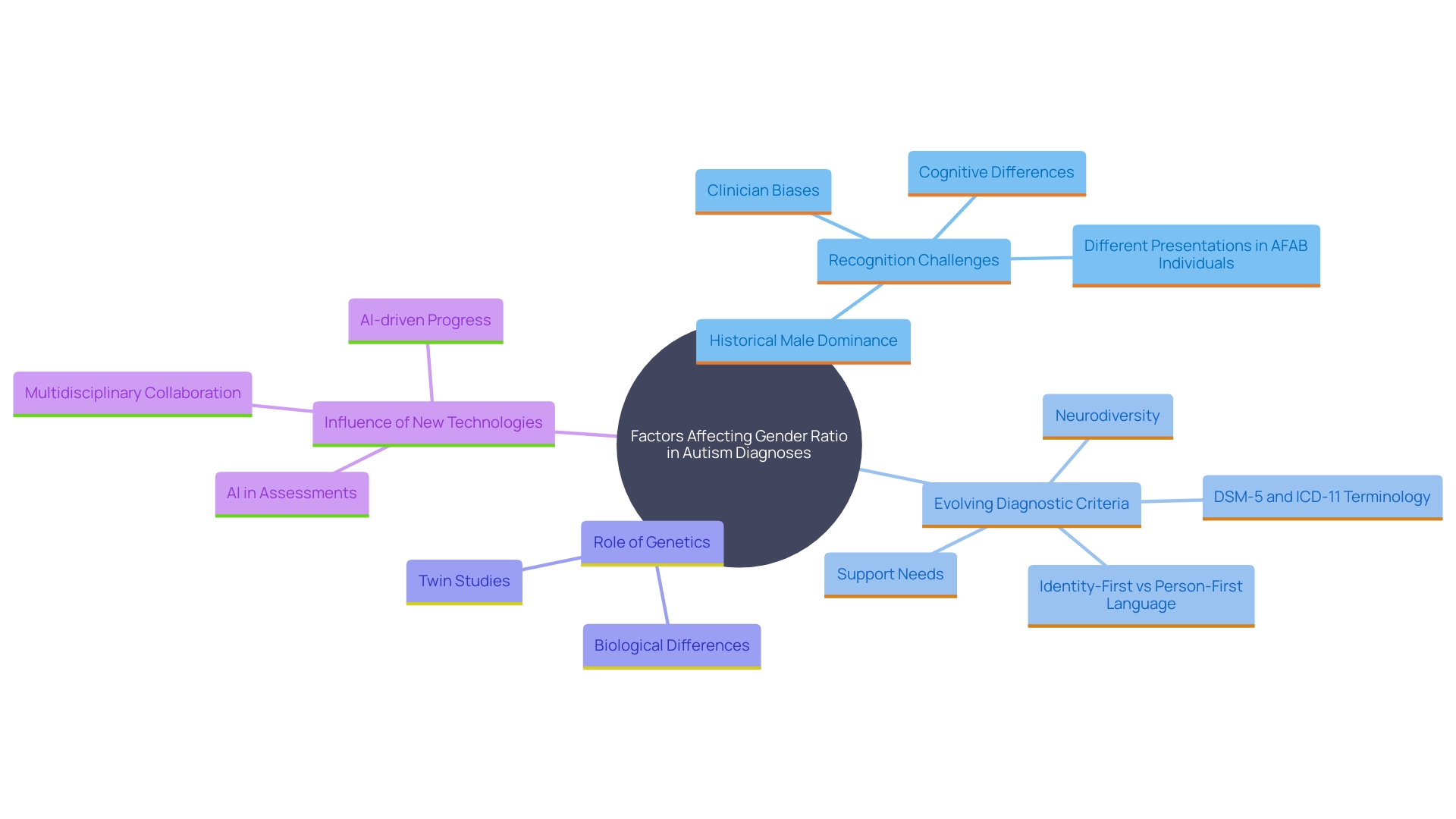
Conclusion
The exploration of autism spectrum disorder (ASD) reveals a complex interplay of biological, genetic, and societal factors that contribute to the significant disparity in diagnosis rates between males and females. The current male-to-female diagnosis ratio of approximately 4:1 prompts deeper inquiry into the reasons behind this phenomenon. Key insights indicate that females often present with subtler symptoms, engage in masking behaviors, and face diagnostic biases, leading to underdiagnosis and delayed support.
These challenges highlight the urgent need for tailored diagnostic approaches that account for the unique behavioral profiles of autistic females.
Understanding the biological factors, including genetic influences and hormonal impacts, is essential for recognizing how autism manifests differently in males and females. The female protective effect hypothesis suggests that biological defenses may require a higher genetic burden for females to exhibit autistic traits. This concept, combined with the recognition of intersectionality, underscores the importance of considering multiple social categories in understanding the experiences of autistic individuals.
Addressing diagnostic biases and improving recognition of female autism is critical for ensuring timely intervention and support. As research continues to evolve, it is imperative to adopt inclusive strategies that empower families and advocates. By enhancing awareness and understanding of these issues, the goal is to create a more equitable landscape for all individuals on the autism spectrum, ensuring that no one is overlooked or underserved in their journey toward well-being and success.




